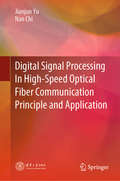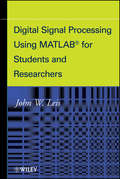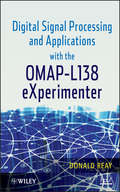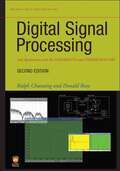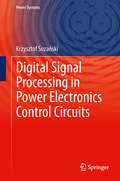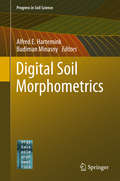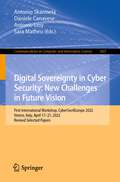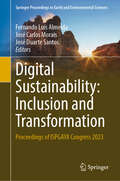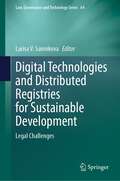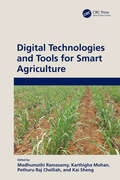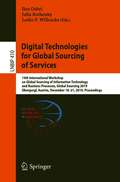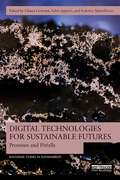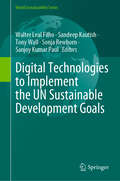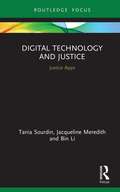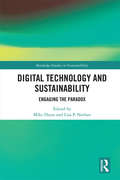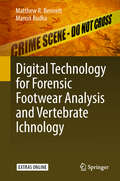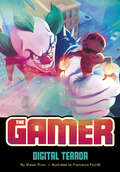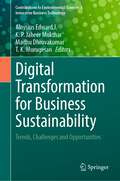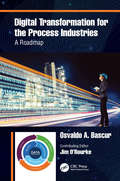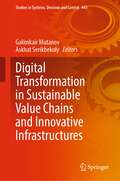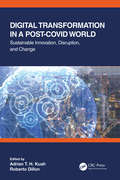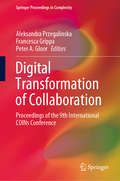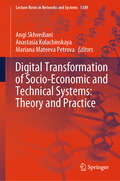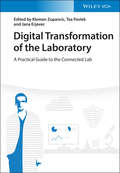- Table View
- List View
Digital Signal Processing In High-Speed Optical Fiber Communication Principle and Application
by Nan Chi Jianjun YuThis book presents the principles and applications of optical fiber communication based on digital signal processing (DSP) for both single and multi-carrier modulation signals. In the context of single carrier modulation, it describes DSP for linear and nonlinear optical fiber communication systems, discussing all-optical Nyquist modulation signal generation and processing, and how to use probabilistic and geometrical shaping to improve the transmission performance. For multi-carrier modulation, it examines DSP-based OFDM signal generation and detection and presents 4D and high-order modulation formats. Lastly, it demonstrates how to use artificial intelligence in optical fiber communication. As such it is a useful resource for students, researches and engineers in the field of optical fiber communication.
Digital Signal Processing Using MATLAB for Students and Researchers
by John W. LeisQuickly Engages in Applying Algorithmic Techniques to Solve Practical Signal Processing ProblemsWith its active, hands-on learning approach, this text enables readers to master the underlying principles of digital signal processing and its many applications in industries such as digital television, mobile and broadband communications, and medical/scientific devices. Carefully developed MATLAB® examples throughout the text illustrate the mathematical concepts and use of digital signal processing algorithms. Readers will develop a deeper understanding of how to apply the algorithms by manipulating the codes in the examples to see their effect. Moreover, plenty of exercises help to put knowledge into practice solving real-world signal processing challenges.Following an introductory chapter, the text explores: Sampled signals and digital processing Random signals Representing signals and systems Temporal and spatial signal processing Frequency analysis of signals Discrete-time filters and recursive filtersEach chapter begins with chapter objectives and an introduction. A summary at the end of each chapter ensures that one has mastered all the key concepts and techniques before progressing in the text. Lastly, appendices listing selected web resources, research papers, and related textbooks enable the investigation of individual topics in greater depth.Upon completion of this text, readers will understand how to apply key algorithmic techniques to address practical signal processing problems as well as develop their own signal processing algorithms. Moreover, the text provides a solid foundation for evaluating and applying new digital processing signal techniques as they are developed.
Digital Signal Processing and Applications with the OMAP-L138 eXperimenter
by Donald ReayTeaches digital signal processing concepts via hands-on examples The OMAP-L138 eXperimenter is the latest inexpensive DSP development system to be adopted by the Texas Instruments University Program. The OMAP-L138 processor contains both ARM and DSP cores and is aimed at portable and mobile multimedia applications. This book concentrates on the demonstration of real-time DSP algorithms implemented on its C6748 DSP core. Digital Signal Processing and Applications with the OMAP-L138 eXperimenter provides an extensive and comprehensive set of program examples to aid instructors in teaching DSP in a laboratory using audio frequency signals-making it an ideal text for DSP courses at senior undergraduate and postgraduate levels. Subjects covered include polling-based, interrupt-based, and DMA-based I/O methods, and how real-time programs may be run using the board support library (BSL), the DSP/BIOS real-time operating system, or the DSP/BIOS Platform Support Package. Chapters include: Analog input and output with the OMAP-L138 eXperimenter Finite impulse response filters Infinite impulse response filters Fast Fourier transform Adaptive filters DSP/BIOS and platform support package Each chapter begins with a review of background theory and then presents a number of real-time program examples to reinforce understanding of that theory and to demonstrate the use of the OMAP-L138 eXperimenter and Texas Instruments Code Composer Studio integrated development environment.
Digital Signal Processing and Applications with the TMS320C6713 and TMS320C6416 DSK (Topics in Digital Signal Processing #17)
by Donald Reay Rulph ChassaingNow in a new edition--the most comprehensive, hands-on introduction to digital signal processingThe first edition of Digital Signal Processing and Applications with the TMS320C6713 and TMS320C6416 DSK is widely accepted as the most extensive text available on the hands-on teaching of Digital Signal Processing (DSP). Now, it has been fully updated in this valuable Second Edition to be compatible with the latest version (3.1) of Texas Instruments Code Composer Studio (CCS) development environment. Maintaining the original's comprehensive, hands-on approach that has made it an instructor's favorite, this new edition also features:Added program examples that illustrate DSP concepts in real-time and in the laboratoryExpanded coverage of analog input and outputNew material on frame-based processingA revised chapter on IIR, which includes a number of floating-point example programs that explore IIR filters more comprehensivelyMore extensive coverage of DSP/BIOSAll programs listed in the text--plus additional applications--which are available on a companion CD-ROMNo other book provides such an extensive or comprehensive set of program examples to aid instructors in teaching DSP in a laboratory using audio frequency signals--making this an ideal text for DSP courses at the senior undergraduate and postgraduate levels. It also serves as a valuable resource for researchers, DSP developers, business managers, and technology solution providers who are looking for an overview and examples of DSP algorithms implemented using the TMS320C6713 and TMS320C6416 DSK.
Digital Signal Processing in Power Electronics Control Circuits
by Krzysztof SozańskiMany digital control circuits in current literature are described using analog transmittance. This may not always be acceptable, especially if the sampling frequency and power transistor switching frequencies are close to the band of interest. Therefore, a digital circuit is considered as a digital controller rather than an analog circuit. This helps to avoid errors and instability in high frequency components. Digital Signal Processing in Power Electronics Control Circuits covers problems concerning the design and realization of digital control algorithms for power electronics circuits using digital signal processing (DSP) methods. This book bridges the gap between power electronics and DSP. The following realizations of digital control circuits are considered: digital signal processors, microprocessors, microcontrollers, programmable digital circuits. Discussed in this book is signal processing, starting from analog signal acquisition, through its conversion to digital form, methods of its filtration and separation, and ending with pulse control of output power transistors. The book is focused on two applications for the considered methods of digital signal processing: an active power filter and a digital class D power amplifier. The major benefit to readers is the acquisition of specific knowledge concerning discussions on the processing of signals from voltage or current sensors using a digital signal processor and to the signals controlling the output inverter transistors. Included are some Matlab examples for illustration of the considered problems.
Digital Signal Transmission
by C. C. Bissell D. A. ChapmanThis book provides an up-to-date and thorough grounding in the concepts of modern digital transmission. It is written in a pedagogic style, aimed at enabling readers to understand the fundamental concepts and processes. System descriptions are included, however the text also explains the basic techniques of transmission, and includes the necessary mathematical background. The basic processes, such as matched filter detection, pulse shaping, line coding, channel coding, error detection and correction, etc. are described in the central part of the book. Understanding the concepts behind these processes requires a grasp of basic mathematical models, and this is provided in the first part of the book. Finally, to put the processes in context, the third part describes elements of the public switched telephone network. The book is written throughout in a modern, digital context, and is comprehensively illustrated with helpful figures. Although the models (time- and frequency-domain concepts) have wider relevance, they are developed specifically for modeling digital systems. The processes described are those found in current transmission systems, and the description of the PSTN includes an outline of newly formulated standards for the synchronous digital hierarchy (SDH), SONET and for broadband ISDN (ATM).
Digital Soil Morphometrics
by Budiman Minasny Alfred E. HarteminkThis book is about digital soil morphometrics which is defined as the application of tools and techniques for measuring, mapping and quantifying soil profile properties, and deriving depth functions of soil properties. The book is structured along four research topics: (i) Soil profile properties, (ii) Soil profile imaging, (iii) Soil depth functions, and (iv) Use and applications. The pedon is at the heart of digital soil morphometrics. The use of digital soil morphometrics exceeds the pedology and soil classification purpose that it currently serves - it is used in rapid soil assessment that are needed in a range of biophysical studies. Digital soil morphometrics has the potential to enhance our understanding of soils and how we view them. The book presents highlights from The IUSS Inaugural Global Workshop on Digital Soil Morphometrics held in June 2015 in Madison, USA.
Digital Sovereignty in Cyber Security: First International Workshop, CyberSec4Europe 2022, Venice, Italy, April 17–21, 2022, Revised Selected Papers (Communications in Computer and Information Science #1807)
by Antonio Skarmeta Antonio Lioy Daniele Canavese Sara MatheuThis book constitutes papers presented during the workshop session titled “CyberSec4Europe - Research to Innovation: Common Research Framework on Security and Privacy” during the Privacy Symposium hosted by Università Ca’ Foscari in Venice, Italy, in April 2022. The 11 peer-reviewed selected papers present findings, conclusions, research, and recommendations in various security-related areas, from highly technical ones (e.g., software and network security) to law and human-centric ones (e.g., governance and cybersecurity awareness).
Digital Sustainability: Proceedings of ISPGAYA Congress 2023 (Springer Proceedings in Earth and Environmental Sciences)
by Fernando Luís Almeida José Carlos Morais José Duarte SantosThis volume contains the proceedings of the 2023 iteration of the ISPGAYA conference, titled “Digital Sustainability: Inclusion and Transformation” and held in Vila Nova de Gaia, Portugal. The conference and resulting book intend to explore the involvement of Portugal, a country on the semi-periphery of the world system, in developments regarding the understanding of and progress toward sustainability. The conference was organized by ISPGAYA, an institution belonging to the private polytechnic higher education system in Portugal, and brought together participants from around the world. This volume intends to establish a milestone in the multidimensional approach to the theme of sustainability, affirming the concept's multi and interdisciplinary nature and bringing together scholars across disciplines.
Digital Technologies and Distributed Registries for Sustainable Development: Legal Challenges (Law, Governance and Technology Series #64)
by Larisa V. SannikovaDigital technologies are playing a growing role in achieving the UN’s Sustainable Development Goals (SDGs). They are both a tool both for achieving developmental outcomes and a driver of change. However, the use of digital technologies also entails certain legal challenges. The purpose of this book is to highlight these challenges and suggest solutions. Written by leading researchers from six countries, who analyse legislative solutions from around the world, it includes chapters on the benefits of asset tokenisation, the role of artificial intelligence in achieving sustainable development, legal issues in the green digital transformation, and human rights in a digital world. Through a mixture of fundamental analysis and real-world examples, readers will learn how emerging digital technologies can help achieve various SDGs and what legal challenges arise from their application. This important resource will be of interest to academics, government and legal officials whose work involves the legal regulation of the introduction and use of new digital technologies, as well as sustainable development challenges. Legal experts engaged in the design of new legal infrastructures during the current phase of digital, climatic and social transformation in private, public and social organizations will also find it useful.
Digital Technologies and Tools for Smart Agriculture
by Pethuru Raj Chelliah Madhumathi Ramasamy Karthigha Mohan Kai ShengTo meet the food requirements of the growing population worldwide, the agricultural domain is being technologically empowered to produce more with fewer resources and investments. Fortunately, the faster maturity and stability of digital (digitization and digitalization) technologies and tools have laid a stimulating and sparking foundation for large-scale production of food items with minimal time, talent, and treasure. The penetration and pervasiveness of the Internet of Things (IoT) sensors and actuators are considered the first and foremost aspect of advanced and adaptive agriculture. Further, the device ecosystem for automated and accelerated agriculture processes and practices grows consistently. The robots and drone space advancements are fascinating, as they are set to transform the industry. Connected robots, drones, and other agriculture equipment, appliances, instruments, and machinery are flourishing towards intelligent agriculture. Agriculture sensors and devices generate a lot of real-time and real-world digital data. With the help of artificial intelligence (AI) methods, all agriculture data are subjected to various deep and decisive investigations to extract actionable insights in time. Other noteworthy improvisations include the widespread deployment of 5G communication networks, the growing power of edge analytics and intelligence, the distinct contributions of blockchain technology, the adoption and adaptation of cloud-native computing principles, the phenomenon of digital twins, etc., in the digital space. All these developments have led to the realization of smart agriculture products, solutions, and services.Features: Delineate the role and responsibilities of digital technologies towards smart agriculture Delve into the potential of IoT and AI, along with other critical technological advancement Demystify large language models (LLMs) and visual language models (VLMs) Dig deep and delve into the advancements in the robots and drone space Describe how digital innovations can significantly elevate agriculture processes, platforms, patterns, and practices This book will delve into the transformative power of digital technologies in agriculture, particularly in the context of smart agriculture. It will highlight how these technologies and innovative digital devices are reshaping the agricultural landscape. The book will also showcase the disruptive potential of these technologies, illustrating how they are revolutionizing traditional farming practices and processes.
Digital Technologies for Global Sourcing of Services: 14th International Workshop on Global Sourcing of Information Technology and Business Processes, Global Sourcing 2019, Obergurgl, Austria, December 18–21, 2019, Proceedings (Lecture Notes in Business Information Processing #410)
by Julia Kotlarsky Ilan Oshri Leslie P. WillcocksThis book constitutes revised selected papers from the 14th International Global Sourcing Workshop 2019, held in Obergurgl, Austria, in December 2019. The 10 contributions included were carefully reviewed and selected from a total of 36 submissions.The book offers a review of the key topics in sourcing of services, populated with practical frameworks that serve as a tool kit to students and managers. The range of topics covered in this book is wide and diverse, offering various perspectives on the employment of digital technologies in the context of sourcing services. More specifically the book examines sourcing decisions and management practices around digital platforms, robotic process automation and blockchain, giving specific attention to digital aspects of innovation in sourcing.
Digital Technologies for Sustainable Futures: Promises and Pitfalls (Routledge Studies in Sustainability)
by Chiara Certomà Fabio Iapaolo Federico MartellozzoThis book critically examines the interplay between digitalization and sustainability. Amid escalating environmental crises, some of which are now irreversible, there is a noticeable commitment within both international and domestic policy agendas to employ digital technologies in pursuit of sustainability goals.This collection gathers a multitude of voices interrogating the premise that increased digitalization automatically contributes to greater sustainability. By exploring the planetary links underpinning the global digital economy, the book exposes the extractive logics ingrained within digital capitalism and introduces alternatives like digital degrowth and the circular economy as viable, sustainable paths for the digital era. Through a combination of theoretical reflections and detailed contextual analyses from Italy, New Zealand, and the UK—including initiatives in participatory planning and technology co-design—it articulates the dual role of digital technology: its potential to support socio-economic and environmental sustainability, while also generating conflicts and impasses that undermine these very objectives. Offering fresh insights into power disparities, exclusionary tactics, and systemic injustices that digital solutionism fails to address, this volume also serves as a reminder that sustainability extends beyond climate-related issues, underscoring the inseparability of environmental discourse from wider social justice considerations.Aimed at a diverse readership, this volume will prove valuable for students, researchers, and practitioners across various fields, including Geography, Urban Studies, Sustainability Studies, Environmental Media Studies, Critical AI Studies, Innovation Studies, and the Digital Humanities.
Digital Technologies to Implement the UN Sustainable Development Goals (World Sustainability Series)
by Walter Leal Filho Tony Wall Sandeep Kautish Sanjoy Kumar Paul Sonja RewhornAgainst this background, and in order to facilitate a broad discussion on the contribution of IT toward implementing the UN SDGs, this book is being produced. The book gathers inputs from universities, enterprises, and research organizations working on matters related to IT and sustainable development in a variety of contexts. It also provides a platform for the dissemination of information on the latest initiatives, paving the way for technology transfer and networking. Last but not least, a further aim of the book is to present methodological approaches and experiences deriving from case studies and projects, which aims to show how IT may support sustainability efforts in a wide range of settings and contexts. Digital technologies are now widely spread and the variety of tools and methods available today means that they can potentially useful in helping to achieve the United Nations Sustainable Development Goals (UN SDGs). However, the gap between technological innovation and sustainable development applications is quite wide. For instance, it is unclear how artificial intelligence can be leveraged to tackle some of the world’s biggest environmental challenges, including climate change, biodiversity, and water management. Also, there is a need to highlight how innovative green technologies and their applications in areas such as renewable energy, waste management, and sustainable agriculture may be used and to showcase how technological innovation can lead to more sustainable production and consumption patterns.
Digital Technology and Justice: Justice Apps
by Bin Li Tania Sourdin Jacqueline MeredithJustice apps – mobile and web-based programmes that can assist individuals with legal tasks – are being produced, improved, and accessed at an unprecedented rate. These technologies have the potential to reshape the justice system, improve access to justice, and demystify legal institutions. Using artificial intelligence techniques, apps can even facilitate the resolution of common legal disputes. However, these opportunities must be assessed in light of the many challenges associated with app use in the justice sector. These include the digital divide and other accessibility issues; the ethical challenges raised by the dehumanisation of legal processes; and various privacy, security, and confidentiality risks. Surveying the landscape of this emergent industry, this book explores the objectives, opportunities, and challenges presented by apps across all areas of the justice sector. Detailed consideration is also given to the use of justice apps in specific legal contexts, including the family law and criminal law sectors. The first book to engage with justice apps, this book will appeal to a wide range of legal scholars, students, practitioners, and policy-makers.
Digital Technology and Sustainability: Engaging the Paradox (Routledge Studies in Sustainability)
by Mike Hazas Lisa NathanThis book brings together diverse voices from across the field of sustainable human computer interaction (SHCI) to discuss what it means for digital technology to support sustainability and how humans and technology can work together optimally for a more sustainable future. Contemporary digital technologies are hailed by tech companies, governments and academics as leading-edge solutions to the challenges of environmental sustainability; smarter homes, more persuasive technologies, and a robust Internet of Things hold the promise for creating a greener world. Yet, deployments of interactive technologies for such purposes often lead to a paradox: they algorithmically "optimize" heating and lighting of houses without regard to the dynamics of daily life in the home; they can collect and display data that allow us to reflect on energy and emissions, yet the same information can cause us to raise our expectations for comfort and convenience; they might allow us to share best practice for sustainable living through social networking and online communities, yet these same systems further our participation in consumerism and contribute to an ever-greater volume of electronic waste.By acknowledging these paradoxes, this book represents a significant critical inquiry into digital technology’s longer-term impact on ideals of sustainability. Written by an interdisciplinary team of contributors this book will be of great interest to students and scholars of human computer interaction and environmental studies.
Digital Technology for Forensic Footwear Analysis and Vertebrate Ichnology
by Matthew R. Bennett Marcin Budka“There is no branch of detective science which is so important and so much neglected as the art of tracing footsteps. Happily, I have always laid great stress upon it, and much practice has made it second nature to me.” Sherlock Holmes, Study of Scarlet.Despite the fictional nature of Sherlock Holmes this statement rings true today. The study of footwear is neglected in modern forensic practice and does have much to offer. What it needs is an injection of technology and modern analytical tools. These tools are emerging from the digital revolution currently transforming vertebrate ichnology. Ichnology is the discipline of earth science which focuses on the study of trace fossils such as footprints. This book draws upon both disciplines - geology (ichnology) and forensic science - to show how the two have much to learn from each other especially with regard to the digital capture and analysis of footprints. This book presents field and laboratory methods associated with the collection, analysis and presentation of three-dimensional tracks (footprints) whether from a crime scene or a geological/archaeological excavation. It shows students, researchers and practitioners how to collect and analyse 3D data and take advantage of the digital revolution transforming ichnology. This book is not only essential reading for forensic and earth science students but also for professional forensic practitioners as well as for applied computer scientists developing new tools for visualization and analysis of 3D data. The book forms a natural methods focused complement to the successful text Fossilised Locomotion published by Springer 2014.
Digital Terror (The Gamer)
by Shawn PryorCriminal Cynthia Cyber finds the most sinister video game monster and pulls him out of the digital world into reality! As the Terror Beast tears down buildings all over the city and creates nightmares for the citizens, the Gamer must use new strategy to beat his fears and stop Cynthia's latest threat!
Digital Transformation for Business Sustainability: Trends, Challenges and Opportunities (Contributions to Environmental Sciences & Innovative Business Technology)
by K. P. Jaheer Mukthar Aloysius Edward J. Madhu Dhruvakumar T. K. MurugesanThis book explores how digital technologies can be used to drive sustainable business practices and achieve long-term business success. It offers insights and practical strategies and guidance that can help businesses adapt to the digital age, optimize their operations, and create new opportunities for growth. The book further provides real-world examples that illustrate how businesses can leverage digital technologies to achieve long-term sustainability and success. The book is an essential read for business leaders, managers, academician, practitioners and entrepreneurs who are looking to drive sustainable digital transformation within their organizations. The book covers a wide range of topics, including:1) Understanding the digital landscape: The book provides an overview of the digital technologies that are transforming business operations, such as artificial intelligence, cloud computing, and the Internet of Things. It explores how these technologies can be leveraged to create sustainable business practices that benefit both the organization and society.2) Building a digital strategy for sustainability: The book offers guidance on how businesses can develop a digital strategy that aligns with their sustainability goals. It covers topics such as identifying digital opportunities, setting targets, and measuring performance.3) Embedding sustainability into digital operations: The book explores how businesses can integrate sustainability into their digital operations, such as data management, supply chain management, and product design. It provides examples of companies that have successfully implemented sustainable digital practices.4) Digital innovation for sustainability: The book discusses how businesses can use digital innovation to create new opportunities for sustainability. It covers topics such as circular economy business models, sustainable product design, and social innovation.5) Leading for sustainable digital transformation: The book offers insights on how business leaders can drive sustainable digital transformation within their organizations. It covers topics such as leadership skills, organizational culture, and stakeholder engagement.
Digital Transformation for the Process Industries: A Roadmap
by Osvaldo A. BascurImagine if your process manufacturing plants were running so well that your production, safety, environmental, and profitability targets were being met so that your subject matter experts could focus on data-driven business improvements. Through proper use and analysis of your existing operations data, your company can become an industry leader and reward your stakeholders. Written in an engaging and easily understandable manner, this book demonstrates a step-by-step process of how an organization can effectively utilize technology and make the necessary culture changes to achieve operational excellence. You will see how several industry-leading companies have used an effective real-time data infrastructure for mission-critical business use cases. The book also addresses challenges involved, such as effectively integrating operational (OT) data with business (IT) systems to enable a more proactive, predictive management model for a fleet of process plants. Some of the things you will take away: Learn how a real-time data infrastructure enables transformation of raw sensor data into contextualized information for operational insights and business process improvement. Understand how reusing the same operational data for multiple use cases significantly impacts fleet management, profitability, and asset stewardship. See how a simple digital unit template representing production flows can be repeatedly used to identify critical inefficiencies in plant operations. Discover best practices of deploying real-time situational awareness alerts and predictive analytics. Realize how to transform your organization into a data-driven culture for continuous sustainable improvement. Find out how leading companies integrate operations data with business intelligence and predictive analytics tools in a corporate on-premises or cloud-enabled environment. Learn how industry-leading companies have imaginatively used a real-time data infrastructure to improve yields, reduce cycle times, and slash operating costs. This book is targeted for process industries production and operations leadership, senior engineers, IT management, CIOs, and service providers to those industries. Academics will benefit from latest data analysis strategies. This book guides readers to use the best, results-proven approaches to ensure operational excellence.
Digital Transformation in Sustainable Value Chains and Innovative Infrastructures (Studies in Systems, Decision and Control #443)
by Galimkair Mutanov Askhat SerikbekulyThis book includes 15 works by scientists of the Eurasian region, which reveal the various stages of the life cycle of digital transformation The creation of value propositions and their distribution chains is important for the sustainable development of society.This view of sustainable value chains on the part of public administration and business, considering modern scientific research, reveals the problems of education and science in the formation of chains sustainability and their infrastructure.Modern views on the actual problems of the digital service in the creation of value propositions with the participation of development institutions, new educational technologies, and state regulation both at the level of the world community and at the level of individual countries are revealed.The problems of digital transformation of economic actors and industries at different stages of the chain of value creation from a position of sustainable development, innovation in the infrastructure of public administration markets are considered.This book is useful to the academic community and a new generation of infrastructure creators to identify vectors to support the innovative development of value chains.
Digital Transformation in a Post-Covid World: Sustainable Innovation, Disruption, and Change
by Roberto Dillon Adrian T. H. KuahThis book explores the innovations, disruptions and changes that are required to adapt in a fast-evolving landscape due to the extraordinary circumstances triggered by the COVID-19 pandemic. Recognized experts from around the world share their research and professional experience on how the working environment, as well as the world around them, have changed due to the pandemic. Chapters consider how different fields across technology and business have been affected by this new, dramatic scenario and the drastic consequences that the pandemic had on them. With diverse contributions stemming from public health, technology strategies, urban planning and sociology to sustainable management, this volume is articulated into four distinct but complementary sections of People, Process, Planet, and Prosperity influencing the post-COVID world. This book will be of great interest to those in the fields of computer science and information technology, as well as those studying the impact and effects that COVID-19 is having on society.
Digital Transformation of Collaboration: Proceedings of the 9th International COINs Conference (Springer Proceedings in Complexity)
by Peter A. Gloor Francesca Grippa Aleksandra PrzegalinskaThis proceedings is focused on the emerging concept of Collaborative Innovation Networks (COINs). COINs are at the core of collaborative knowledge networks, distributed communities taking advantage of the wide connectivity and the support of communication technologies, spanning beyond the organizational perimeter of companies on a global scale. The book presents the refereed conference papers from the 7th International Conference on COINs, October 8-9, 2019, in Warsaw, Poland. It includes papers for both application areas of COINs, (1) optimizing organizational creativity and performance, and (2) discovering and predicting new trends by identifying COINs on the Web through online social media analysis. Papers at COINs19 combine a wide range of interdisciplinary fields such as social network analysis, group dynamics, design and visualization, information systems and the psychology and sociality of collaboration, and intercultural analysis through the lens of online social media. They will cover most recent advances in areas from leadership and collaboration, trend prediction and data mining, to social competence and Internet communication.
Digital Transformation of Socio-Economic and Technical Systems: Theory and Practice (Lecture Notes in Networks and Systems #1309)
by Angi Skhvediani Mariana Mateeva Petrova Anastasia KulachinskayaIn the theoretical field, this book presents innovative concepts and models that elucidate the dynamics and implications of digitalization across diverse socio-economic systems. Additionally, from a practical perspective, the book offers real-world examples and case studies that illustrate successful strategies for implementing digital technologies and their contributions to the sustainable development of various industries. In recent years, digital economy has become a key driver, which fosters growth of various systems. The COVID-19 pandemic has additionally boosted this process and resulted in higher effectiveness of both formal and informal institutes, structural changes on labour market, new opportunities for social mobility, new markets, new forms of interaction between government, individuals, and enterprises. On the other hand, these processes entailed significant challenges among which are digital divide, cyber security, high costs of process digitalization, etc. This book is designed for researchers, educators, students, and practitioners interested in acquiring profound insights into the contemporary processes of digital transformation and their impact on socio-economic and technical systems.
Digital Transformation of the Laboratory: A Practical Guide to the Connected Lab
by Klemen ZupancicThis practical book in instrumental analytics conveys an overview of important methods of analysis and enables the reader to realistically learn the (principally technology-independent) working techniques the analytical chemist uses to develop methods and conduct validation. What is to be conveyed to the student is the fact that analysts in their capacity as problem-solvers perform services for certain groups of customers, i.e., the solution to the problem should in any case be processed in such a way as to be "fit for purpose". The book presents sixteen experiments in analytical chemistry laboratory courses. They consist of the classical curriculum used at universities and universities of applied sciences with chromatographic procedures, atom spectrometric methods, sensors and special methods (e.g. field flow fractionation, flow injection analysis and N-determination according to Kjeldahl). The carefully chosen combination of theoretical description of the methods of analysis and the detailed instructions given are what characterizes this book. The instructions to the experiments are so detailed that the measurements can, for the most part, be taken without the help of additional literature. The book is complemented with tips for effective literature and database research on the topics of organization and the practical workflow of experiments in analytical laboratory, on the topic of the use of laboratory logs as well as on writing technical reports and grading them (Evaluation Guidelines for Laboratory Experiments). A small introduction to Quality Management, a brief glance at the history of analytical chemistry as well as a detailed appendix on the topic of safety in analytical laboratories and a short introduction to the new system of grading and marking chemicals using the "Globally Harmonized System of Classification and Labelling of Chemicals (GHS)", round off this book. This book is therefore an indispensable workbook for students, internship assistants and lecturers (in the area of chemistry, biotechnology, food technology and environmental technology) in the basic training program of analytics at universities and universities of applied sciences.
